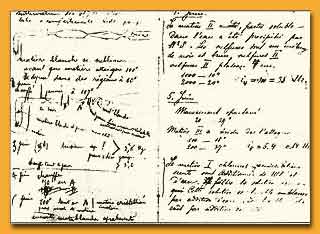|
Making repeated separations
of the various substances in the pitchblende, Marie and Pierre used
the Curie electrometer to identify the most radioactive fractions.
They thus discovered that two fractions, one containing mostly bismuth
and the other containing mostly barium, were strongly radioactive.
In July 1898 the Curies published their conclusion: the bismuth
fraction contained a new element. Chemically it acted almost exactly
like bismuth, but since it was radioactive, it had to be something
new. They named it "polonium" in honor of the country of Marie's
birth. A second publication, in December
1898, explained their discovery in the barium fraction of another
new element, which they named "radium" from the Latin word for ray.
The Curies were close to reaching one of the highest goals that
a scientist of the time could hope to achieve--placing new elements
in the Periodic Table. While the chemical
properties of the two new elements were completely dissimilar, they
both had strong radioactivity.
 |
A page from the Curies' lab notebook of
1898. On the left, in Pierre's hand, a sublimation procedure.
On the right, in Marie's hand, chemical processing. (Photo
ACJC) Another
picture
Read the Discovery
Paper in which the Curies announced the existence of Radium...
|
 O
CONVINCE THE SCIENTIFIC COMMUNITY of the existence of polonium
and radium, and to complete the identification and establish the
nature of the new elements, Marie set out to isolate them from the
bismuth and barium with which they were mixed. Since the Municipal
School storeroom would be inadequate to the task, the Curies moved
their lab to an abandoned shed across the school courtyard. The
shed, formerly a medical school dissecting room, was poorly outfitted
and ventilated. It was not weathertight. She succeeded in separating
the radium from the barium only with tremendous difficulty -- which
would become central in the romantic legend
of her life. She had to treat very large quantities of pitchblende,
a ton of which the Curies received as a donation from the Austrian
government. (The Austrians hoped she would find a use for a mineral
their mines yielded as a waste byproduct.) O
CONVINCE THE SCIENTIFIC COMMUNITY of the existence of polonium
and radium, and to complete the identification and establish the
nature of the new elements, Marie set out to isolate them from the
bismuth and barium with which they were mixed. Since the Municipal
School storeroom would be inadequate to the task, the Curies moved
their lab to an abandoned shed across the school courtyard. The
shed, formerly a medical school dissecting room, was poorly outfitted
and ventilated. It was not weathertight. She succeeded in separating
the radium from the barium only with tremendous difficulty -- which
would become central in the romantic legend
of her life. She had to treat very large quantities of pitchblende,
a ton of which the Curies received as a donation from the Austrian
government. (The Austrians hoped she would find a use for a mineral
their mines yielded as a waste byproduct.)
Luckily some help
was available for the tedious labor of treating the pitchblende.
They were able to collaborate with the Central Chemical Products
Company, the firm that marketed Pierre's scientific instruments.
Their colleague André Debierne cleverly adapted their standard lab
techniques into larger-scale industrial processes. These processes
isolated from the pitchblende materials with high concentrations
of radium and polonium, which the Curies studied in detail in what
she called the “miserable old shed.” In exchange for supplying
chemical products and paying staff wages, the Central Chemical Products
Company took a share of the radium salts extracted on its premises.
The firm would later make a handsome profit by marketing these radium
salts for medical and other uses.
Despite the industrial
assistance the Curies received, it took Marie over three years to
isolate one tenth of a gram of pure radium chloride. For reasons
that would not be fully understood until the concept of radioactive
decay was developed, Marie never succeeded in isolating polonium,
which has a half-life of only 138 days.
� 2000
-
American Institute of Physics |

